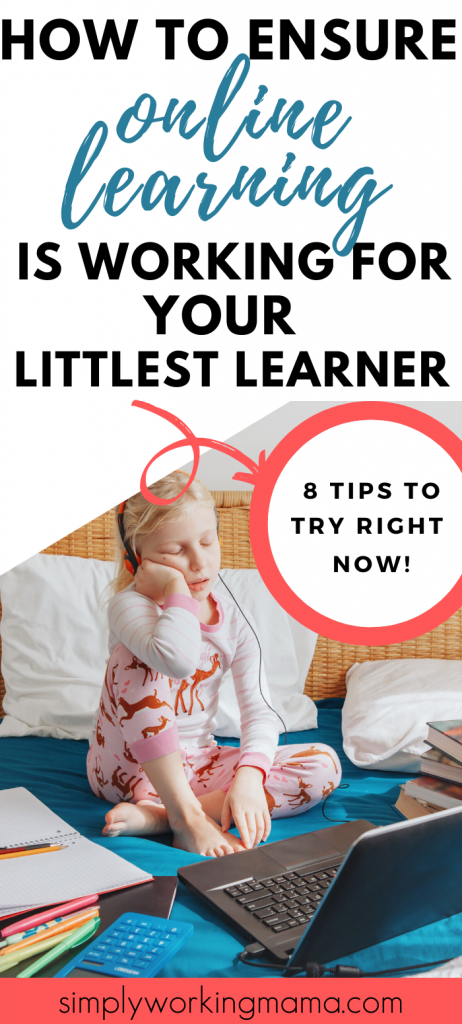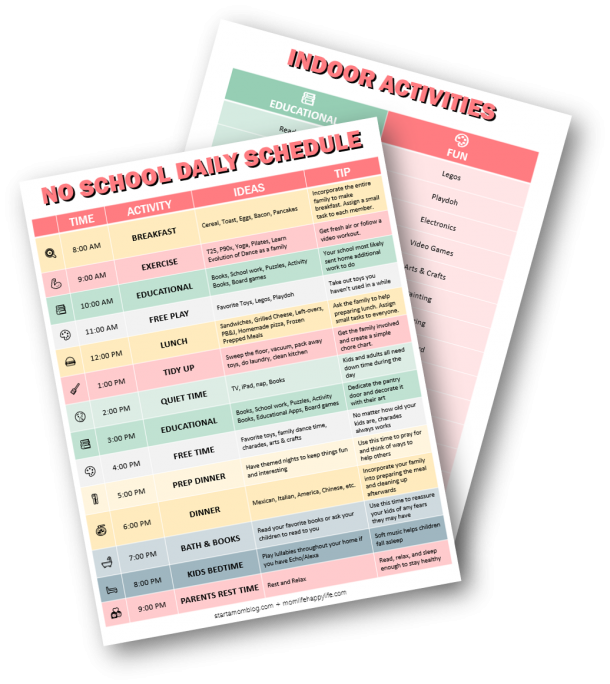You are on mute for a Zoom call for work while your 5-year-old’s tears could literally flood your living room because they don’t understand their online learning assignment. Meanwhile, you have laundry in the wash and lunch in the microwave…I’m talking about heating up last night’s leftovers because who has time to get gourmet right now…
By the end of the day, you have exhaustion written all over your face and are wondering if your child actually learned anything today during “school”.
Unfortunately for the situation, we find ourselves facing right now, online learning is not ideal for our youngest learners. Our Pre-K and Kindergartners are so far removed from the tools they need to successfully develop academically, socially, and emotionally that they are suffering the most from this sudden transition, despite how hard teachers are working right now.
These little learners need plenty of support from you to help them with the curriculum during this temporary online schooling.
So how can you do this successfully while maintaining your sanity?

What Online Learning Should Look Like
Online learning can present itself in many formats, but there are a few best practices that you should notice when working with your child.
Engagement in Online Learning
These lessons above all else have to be engaging. During live lessons taking place in the classroom, there is plenty of interaction between teachers and students. Students are getting up to participate in a lesson or they are chatting with their peers about a question the teacher posed. This is engagement in learning.
Unfortunately, with virtual learning, teachers have to get creative because students are staring at a 2-dimensional screen for learning. And while this may be new and exciting at first, it can get old very quickly and become difficult to maintain those little attention spans.
Hopefully, you are seeing your child’s teacher trying to up the engagement of lessons by sharing videos and interactive activities for your child to do.
Lesson Flow of Online Learning

While the format of learning may be different now, the science of how the brain learns has not changed.
There are two popular flows for online learning that I have been seeing over the past couple of weeks.
The first is instruction and modeling (live teaching or videos), followed by student practice with feedback from the teacher, and then some sort of assignment to show what was learned.
The second is a more progressive approach where students collect information from various sources about a learning objective, draw a conclusion, and then the teacher confirms or addresses misconceptions to solidify the learning.
Either way, there is some form of instruction that is actually teaching your child what s/he needs to learn and there is some way that your child can demonstrate that s/he understood the concept.
Why Online Learning is Not Ideal for Emerging Readers
Unfortunately, when we look at the types of lesson flows from above, they aren’t really ideal for our littlest learners in a digital setting. Young students love to do hands-on, kinesthetic, and interactive learning.
Before COVID-19 forced its way into our lives, virtual preschools and primary schools were starting to emerge as a new way to provide instruction. Research studies showed multiple factors as to why this new type of schooling while having the possibility of being beneficial, is not the ideal format for our youngest learners (source). Here’s why:
Lacks Social Interaction
One of the most beneficial parts of early education for young students is the chance to interact with others in a social setting.

With Friends
When socializing with peers, children are able to learn important skills such as empathy, sharing, making friends, and getting along with others. An online learning space doesn’t allow for these real-life learning situations that naturally present themselves multiple times per day in a classroom.
And young children without siblings are at an even greater disadvantage. They have no peers with whom they can construct their social learning.
With Teachers
Teachers also play an important role in the development of social skills. They can help a child learn how to focus and follow directions. Aside from these important social skills, teachers also help children learn how to hold a pencil or scissors, important fine motor skills that children need in school. Online learning, though, doesn’t involve a lot of pencil or scissor usage, decreasing opportunities to continue strengthening those fine motor skills.
Teachers also provide a lot of social interaction during instruction as well. There are many opportunities during a read-aloud for children to point to items on a page or to move a piece on the felt storyboard to retell a favorite story. Getting children physically involved in their learning assists with transferring information from short-term to long-term memory, making it “stick”.
Less Support for Language Development
Oral language development is a crucial component of early literacy. With online learning, there can be formal instruction in vocabulary or some language development, but it is not up to par with what is necessary to lay a strong foundation in literacy.
The key to language development is to ensure that new words or language structures are used in context and the learner is provided accurate and timely feedback. Learning a language also means learning to communicate. This entails understanding and using social cues and body language.
Virtual language development places a screen in between the learning and removes context from the learner, resulting in language instruction that lacks communication because it is only one-sided. Children will have a harder time discerning social cues and body language through a screen. This then causes the development of these nonverbal cues to fall behind as well.

Early Literacy Skills Can Suffer
There are many parts of early literacy that can suffer as a result of online learning. In addition to language development, print awareness and phonological awareness are more examples.
Print awareness and phonological awareness are two skills that require a lot of interaction with immediate feedback to correct misconceptions. While these skills may be modeled online, virtual learning does not meet the need that learners have for interaction in order to become successful with these skills.
Watching someone on a screen point to the cover of a book and telling you where the title is maybe nice to watch, but your child will learn significantly more by doing. When you show them a book and have them hold it and manipulate it to find the cover and title, they are able to learn with a higher rate of retention.
5 Tips to Support Your Littlest Learner with Online Learning
As we have discussed, online learning is not ideal for our youngest learners, yet it has become our reality.
Teachers have a lot to think about when creating their online instruction. Even when they are working their hardest to provide the best for our children, Pre-K and Kindergarten instruction can still lack the personal interaction that a young learner needs.
So where does this burden fall? On you, the parent. Here are some easy ways to support your little one in their online adventure.

1. Give lots of breaks
As you may have noticed, your little one doesn’t have the longest attention span. Teachers aren’t creating lesson plans with the intention that your child sits in front of the computer for 5 hours per day. They want you to segment instruction into smaller chunks of time. The average daily schooling should be approximately 2-3 hours long.
Provide breaks for your child after every 15-20 minutes. This could be a short break like dancing to a favorite song on YouTube or a longer walk outside.
2. Create a Dedicated Workspace
Your child is not used to having to do structured schoolwork in your home. Create a special learning space to separate play time from learning time. Providing a special learning workspace will help your little one understand that when they are in this space, they need to be focused and working hard.
3. Provide Plenty of Time for Play and Movement
It’s more important now than ever to provide time for play and movement during the day. Just like you may need to sip a glass of wine to decompress after a long day, your child needs to be able to let off steam and run around. Learning online should not mean that your house turns into a school 24/7.

4. Make Assignments More Interactive
One of the best things you can do to help your child during this transition is to make the online assignments more interactive. Some simple materials you have around the house can help you with this. Here is an example:
Let’s say your child’s teacher has asked your child to click on the screen every time they see the letter a. While this is interactive in a sense, you can exponentially increase interaction by using post-it notes or index cards to write individual letters on. Hide them around a room where your child can see them and then have them try to find all of the cards that have the letter a.
Don’t forget to get creative with markers, crayons, scissors, and glue. Your child needs to practice those fine motor skills in addition to academics.
5. Create a Schedule
Our young children thrive on routines. They were so used to the routine of going to school and following a schedule. Then all of a sudden, their routines were unexpectedly ripped from under their feet.
To help them know what to expect while at home, create a visual schedule using pictures and words that let them know when it is time for playtime, schoolwork, and lunch. They will appreciate having some sort of consistency and it will save you from a headache.
This will also be a much-needed sanity-saver for you, too. If you are working from home, you may be wondering how to do all of these tips I am sharing with you. With a schedule, all is possible! Schedule in when you will provide 1:1 instruction time for your child’s schooling. Dedicate that time to just them. On the flip side, schedule independent play time so that you can ensure your work gets done too.
3 Ways to Supplement Online Literacy Learning
Even with the fact that this new reality of virtual learning is not the best scenario for our emergent readers, there are ways that you can ensure that your little one doesn’t fall behind in their literacy skills.
1. Incorporate Literacy into Existing Play
Whatever play you are already doing with your little one at home, why not throw in some literacy opportunities as well? Playing a game with toy cars? Make a pretend road on butcher paper or with chalk outside. Write some letters or sight words on the road. Every time your child passes a letter or word with their car, they have to tell you what it is.
Get some more ideas for how to encourage literacy through play.
2. Get Creative with Sight Words
Learning sight words can be a lot of fun for your child if you know how to turn them into a game. Here are a couple of ideas:
Sensory
Take advantage of your child’s need for sensory input by using shaving cream, rice, sand, or another engaging medium to practice writing sight words in.
Missing Letters
Use magnetic letters or a dry erase board to spell a sight word. Erase or take away one letter and have your child tell you what letter is missing. You can repeat as many times as you would like, take away more than one letter, or even take away an entire word. The mystery of what will be missing can hold your child’s attention. This also provides repeated exposure and practice to spelling and recognizing important sight words.
Find It and Fix It
Find the magnetic letters to spell the word that you are focusing on. Hide the letters in a sensory bin or you can hide them around your house. Have your child find the letters and put them in the correct order.
Depending on where your child is in their development, you can either tell them what the word is before they start to find it, or let them try to figure it out on their own.
3. Keep Reading With Your Child Every Day

If you do nothing else, read with your child every single day. Virtual school can be very overwhelming and research has shown us time and again that the most powerful thing you can do with your child at home is to read with them.
Ask your little one to point to things they find in pictures or read some of the words with you. No matter how you are reading, the important thing is that you are reading.
Final Thoughts on Online Learning with our Littlest Learners
While our new temporary reality isn’t really convenient and can cause a lot of headaches, I truly feel that there will be good that comes out of this experience.
You are already being proactive and trying to help your child in any way you can so that they can be successful in their online learning adventure.
Know that no matter how tough it gets, you are doing your very best and your child (and their teacher) appreciates you more than you realize. You will emerge on the other side of this knowing how to help your child strengthen their literacy skills with or without a computer.



